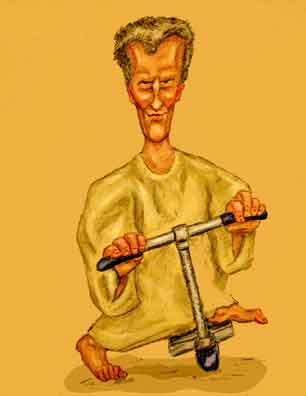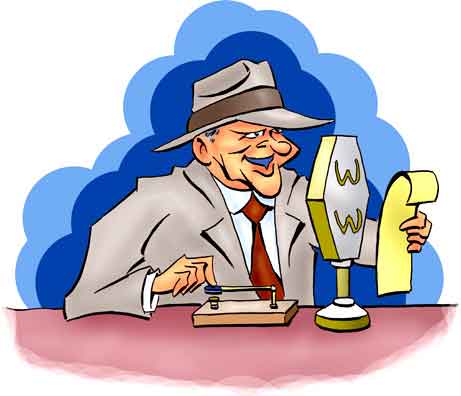
It's often forgotten that in the olden days - we're talking about the Swinging Sixties - that there were people who were shocked! shocked! at the music that the teenagers were listening to.
After all, just look at the libertine lyrics that came wafting off the airways in 1963 to the shock and dismay of parents everywhere.
A fine little girl, she waits for me.
Me catch your ship across the sea.
Me sailed that ship, ah, all alone.
Me never think now I'll make it home.
Ah, Louie, Louie,
Oh, no, say we gotta go.
It's not surprising that there were radio stations that actually banned the song from the airways - lest the young and impressionable be irredeemably corrupted.
But a scant two years later, many a parent were admonishing their teenagers who were listening to lyrics like:
Another bride, another June,
Another sunny honeymoon.
Another season, another reason
For making whoopee.
This of course was the song "Making Whoopee" performed by pianist and singer Ray Charles. The meaning of the words could scarce be clearer - or more scandalous.
Ray, of course, had a number of other records on the charts. In addition to "Making Whoopee", these included Georgia On My Mind (1960), Ruby (1960), Hardhearted Hannah (1960), Come Rain Or Come Shine (1960), Let The Good Times Roll (1960), Don't Let The Sun Catch You Cryin' (1960), One Mint Julep (1961), I've Got News For You (1961), I'm Gonna Move To The Outskirts Of Town (1961), I Can't Stop Loving You (1962), You Are My Sunshine (1962), You Don't Know Me (1962), Your Cheating Heart (1962), Born To Lose (1962), Careless Love (1962), Take These Chains From My Heart (1963), That Lucky Old Sun (1963), No One (1963), Without Love (There Is Nothing) (1963), My Heart Cries For You (1964), No One To Cry To (1964), A Tear Fell (1964), Crying Time (1965), Cry (1965), I'm A Fool To Care (1965), Let's Go Get Stoned (1966), Together Again (1966), You're Just About To Lose Your Clown (1966), Here We Go Again (1967), In The Heat Of The Night (1967), Yesterday (1967), I Want To Talk About You (1967), Understanding (1968), Eleanor Rigby (1968), That's A Lie (1968), Sweet Young Thing Like You (1968), Listen, They're Playing My Song (1968), Let Me Love You (1969), If You Were Mine (1970), Laughin' And Clownin' (1970), Don't Change On Me (1971), Feel So Bad (1971), What Am I Living For (1971), Look What They've Done To My Song, Ma (1972), Come Live With Me (1973), I Can Make It Through The Days (But Oh Those Lonely Nights) (1973), Living For The City (1975). Making Whoopee was released in December 1964 and reached #21 on the charts in January 1965 - a quite respectable showing for Rhythm and Blues particularly during the heyday of the Four Lads from Liverpool.

Four Lads
But it didn't take long for the kids to find out - by watching the late night movies1 - that their PARENTS had been listening to the same song when THEY were kids. Shoot, their GRANDPARENTS listened to the song.
Footnote
The Late Night Movies were an institution in the days when there was only one television set per family and parents often went out on Fridays and Saturdays leaving their older kids on their own or the younger kids with a babysitter. So after the nightly news program was done there would be a movie - usually cut down to about 75 minutes to allow the commercials to fit in a 90 minute time slot.
Although the kids would sometimes see movies like Whoopee!, they usually preferred to watch the "horror" movies. They'd pop up a big batch of popcorn and in addition to the classics like Frankenstein, The Wolfman, The Mummy, Dracula, The Creature from the Black Lagoon, and The Blob, they'd watch movies like Valley of the Zombies, The Man Who Wouldn't Die, The Beast with Five Fingers, The Man Who Could Cheat Death, Blood of the Vampire, Cat Girl, The Lady and the Monster, A Light in the Window, The Woman in Green, Night Monster, Dr. Renault's Secret, Daughter of Dr. Jekyll, Whispering Ghosts, The Tingler, Man Made Monster, The Return of Dracula, Abbott and Costello Meet the Killer, House of Frankenstein, Return of the Fly, Son of Ingagi, The Cat Creeps, The Screaming Skull, The She-Creature, Voodoo Man, Back from the Dead, The Brain Eaters, Murder, He Says, Black Cat Mansion, Alias Nick Beal, The Ghost Catchers, The Monster Maker, Abbott and Costello Meet Frankenstein, The Raven, The Crawling Eye (The Trollenberg Terror), The Mummy's Hand, Cat People, Plan 9 from Outer Space, Monster on the Campus, Return of the Ape Man, The Unseen, House on Haunted Hill, The Woman Eater, The Mad Doctor of Market Street, The Monster That Challenged the World, King of the Zombies, Curse of the Faceless Man, The Invisible Man Returns, The Spider Woman Strikes Back, A Bucket of Blood, The Horror of Dracula, The Catman of Paris, Caltiki – The Immortal Monster, House of Dracula, The Mummy's Tomb, Before I Hang, The Vampire's Coffin, It!, The Terror from Beyond Space, Captive Wild Woman, The Vampire's Ghost, The Man with Nine Lives, The Creeper, The Return of the Vampire, Cry of the Werewolf, The Climax, Beast from Haunted Cave, Attack of the Crab Monsters, The Ghost of Yotsuya, The Ghost of Frankenstein, The Devil Bat, The Tower of the Seven Hunchbacks, She-Wolf of London, The Uninvited, Fog Island, Dead Men Walk, I Walked with a Zombie, The Undead, The Devil Commands, The Mummy (remake), Voodoo Woman, The Aztec Mummy, The Giant Gila Monster, Frankenstein Meets the Wolf Man, The Face Behind the Mask, The Flying Serpent, Dr. Jekyll and Mr. Hyde, The Robot vs the Aztec Mummy, The Mole People, The Monster and the Girl, Fantomas Against Fantomas, Pharaoh's Curse, From Hell It Came, The Fly, Strangler of the Swamp, The Ape Man, Blood of Dracula, The Corpse Vanishes, You'll Find Out, The Ghost Breakers, The Disembodied, The Bellman, Revenge of the Zombies, The Alligator People, The Undying Monster, Crazy Knights, Master Minds, Horror Island, Voodoo Island, The Devil Bat's Daughter, The Door with Seven Locks, The Dark Mirror, Island of Doomed Men, The Man and the Monster, Space Master X-7, Son of Dracula, The Mummy's Curse, The Amazing Mr. X, The Crying Woman), The Ape, Terror Is a Man, The Devil's Commandment), Spook Chasers, Jungle Woman, The Face of Marble, The House of Fear, The Mad Ghoul, Man Beast, The Invisible Man's Revenge, The Man in Half Moon Street, Curse of the Aztec Mummy, Isle of the Dead, The Seventh Victim, The Four Skulls of Jonathan Drake, Carnival of Sinners, Invisible Ghost, The Thing That Couldn't Die, The Soul of a Monster, The Picture of Dorian Gray, The Black Cat, The Bride and the Beast, Corridors of Blood, The Mask of Diijon, Weird Woman, Teenagers from Outer Space, The Hideous Sun Demon, I Bury the Living, Terror in the Haunted House (My World Dies Screaming), House of Horrors, Giant from the Unknown, Ghost of Dragstrip Hollow, The Curse of Frankenstein, The Lodger, The Head, Uncle Was a Vampire (Hard Times for Vampires), Spooks Run Wild, The Mummy's Ghost, The Boogie Man Will Get You, Attack of the Giant Leeches, Hangover Square, The Giant Claw, Black Friday, The Leopard Man, The Vampire, Night of the Demon (Curse of the Demon), The Black Scorpion, Dr. Cyclops, The Abominable Snowman of the Himalayas, Dead of Night, Macabre, Curse of the Undead, Jack the Ripper, The Castle of the Monsters, The Jungle Captive, The Haunted Strangler (Grip of the Strangler), Zombies on Broadway, Mahal, The Mad Monster, and Night Has a Thousand Eyes.
Once home videos became widely available in the 1980's the institution of the Late Night movies faded. By the turn of the Millennium the VHS tapes were being replaced by the DVD's which themselves were a surprisingly short lived phenomenon and their use declined once digitalized streaming became available. Now of course you can simply reach into your pocket, pull out a preferred device, and watch Frankenstein, The Wolfman, The Mummy, Dracula, The Creature from the Black Lagoon, and, yes, The Blob. But it's clearly not the same.
"Making Whoopee" was in fact written in 1928 by Gus Kahn and Walter Donaldson and was the signature song of the Broadway musical Whoopee! The show starred the "banjo-eyed" singer Eddie Cantor and was produced by none other than Florenz Ziegfeld of Ziegfeld Follies fame.

Ludwig Wittgenstein
It's the context.
Of course, the word whoopee itself is not objectionable. Instead as we learn from Ludwig Wittgenstein it is context that gives meaning to a word or phrase. The debate, we must add, is less when whoopee was first used but when it was first used with Ray and Eddie's connotation.
The first stop for any fledgling linguistic scholar is the venerable Oxford English Dictionary of the English Language. This multi-volume publication strives to list the first known use of all English words but unfortunately it is not readily accessible to the general public.2
Footnote
A surprising number of libraries have the OED (as it's called). Of course, you can't check the volumes out but it is true - although increasingly forgotten - that spending time in a library can be a pleasant and tranquil experience.
But if the volumes can be located, the scholar finds that the earliest attestation (as the eggheads call it) for the word "whoopee" is from 1827 in the Augusta Chronicle from Augusta, Georgia. Indeed if you peruse the old copies of the Chronicle - which are surprisingly accessible - you'll find an article printed on September 18, 1827, about Andrew Jackson who was about halfway through his four year campaign for President.
The story "reported" (note quotes) a dialogue between two soldiers. One was a Major Snortum and the other a Captain Bobtail who at one point said.
I say, Major, only to think that we are now, for the sake of office, and to keep up our party, compelled to bawl out "Hurrah for Jackson! Whoopee for Old Hickory!"
So the earliest recorded instance of the word "whoopee" is an exclamation of approbation and approval.
This meaning seems to have persisted past the fin de siècle and is found in the 1904 song "The Fox Chase":
Boys, blow up the dogs and let's have a fox-chase.
Get the horn and give a toot.
Call up the dogs and we'll go down on the creek.
Whoopee! Go it, Lead!
And of course there's the classic volume of authentic cowboy songs collected by native Texan and folk scholar John Avery Lomax. It was first published in 1910 and one of the most famous songs is:
Whoopee-ti-yi-yo! Get along, little dogies.
It's your misfortune and none of my own.
Whoopee-ti-yi-yo! Get along, little dogies.
You know Wyoming will be your new home.
The word continued to be used as a general cry of approval well into the second decade of the 20th Century. In the 1926 issue of the magazine The Commonweal3, we read:
"Whoopee!" he cried, as with his other hand, he waved on high a magnum of champagne. "Happy Old Year!"
But diligent searching through a sampling of publications has shown no - that's NO! KEINS! NICHTS! - instances of the phrase "making whoopee" before 1928. When apparent earlier citations have been found they are inevitably from publications from 1928 or later but were bound together with other earlier volumes.
So it's hard to deny that the musical was responsible for the widespread popularity of the word used in the famous phrase. That does not, though, mean, the musical was without criticism. As one reviewer wrote:
If the last half of "Whoopee," - Eddie Cantor's vehicle which promises to remain at the New Amsterdam all summer - if "Whoopee" is any criterion, Mr. Ziegfeld does well to announce that he will not produce any more reviews. For to this observer, at least, the old formula, which has admittedly become pretty well shop-worn in the hands of a dozen other producers, has now failed even Mr. Ziegfeld himself.
But a vehicle promoting popularity is not the same as the phenomenon's origin, and the actual origin of the phrase "making whoopee" was still debatable. Not that there weren't opinions, mind you. In the 1930's Mark Hellinger, who was a film producer and writer in the first half of the 20th century, stated unequivocally:
I happen to know, for example, that [Walter] Winchell unquestionably coined the word "whoopee" in its modern sense. We sat together in the old Guinan club4 the night he hit upon it. Yet the men with the long whiskers and the short sights now insist that the credit for "whoopee" goes to Shakespeare. And it wouldn’t surprise me at all if somebody arose tomorrow with the claim that Anthony wired it to Cleopatra whenever he wanted to bury Caesar.5
Footnote
The mention of the Guinan Club (pronounced GUY-nan) is a reference so obscure today that it requires considerable elaboration. But at the time its mention was so obvious that it required no explanation.
The Guinan Club was a New York night club - one it must be mentioned out of many - hosted by Mary Louise Cecilia Guinan known to the pubic as "Texas" Guinan. Her clubs were famous - some said notorious - as they were well known and yet openly sold alcoholic drinks during Prohibition. Major celebrities frequented her night clubs where she sang songs and bantered with the customers. Her trademark greeting as she came on stage was "Hello, suckers!"
But "the Guinan club" most likely refers specifically to the Three Hundred Club on West 54th Street in Manhattan. It was raided and padlocked on several occasions but Miss Texas managed to re-open, sometimes within days of the raid.
Texas Guinan always maintained that she never drank nor did she sell alcohol. Instead she said she was paid purely as a performer. Nevertheless she was occasionally arrested during the raids and might be charged with offenses such as "possessing liquor", "selling liquor", or "keeping a nuisance". There were also times that her clubs would be raided but she would not be arrested although the other employees who were clearly involved in operating the clubs were.
Ironically Texas Guinan died at age 49 of amoebic dysentery contracted from drinking water in 1933 - the year prohibition ended.
Footnote
"Whoopee" and certainly "making whoopee" do not appear in any of Shakespeare's plays. However, the word "whoop", as an exclamation is found in The Winter's Tale (Act IV, Scene III) and King Lear (Act I, Scene V). The word "whoop'in" - as Shakespeare wrote it - is found in As You Like It (Act III, Scene II).
Walter Winchell - for those who are not students of America's tabloid journalism - has been credited with inventing the gossip column. He began writing in the early 1920's but in 1930 Walter also began radio broadcasts where to give an even greater sense of immediacy to his news, he punctuated his narration with beepbeepbeepbeep-beepbeepbeep-beepbeep telegraph signals.6 He started each show saying, "Hello, Mr. and Mrs. America, from border to border and coast to coast, and all the ships at sea." From the 1930's and to the 1950's Walter's was the most listened to radio program in America.
It wasn't just Walter's news that got people reading his columns and listening to his broadcasts. He also invented words and phrases. His "Winchellisms" like "nothing recedes like success", referring to a couple expecting a baby as "infanticipating", liquor being "giggle water" or "fun milk", and Broadway as "The Grandest Canyon" were not accidental malapropisms à la Yogi Berra. Instead Walter carefully crafted and selected his linguistic creations.
As far as Mark's claims, there is an article from March 17, 1928 - before the musical opened - where we read:
A glossary of some of Winchell's more famous contributions to the dictionary of trick names would read as follows:
"Hush house" or "sotto voce parlo" ... speakeasy.
"Coasting" ... grafting meals and drinks from friends until payday.
"Main Stem" "Coffee Pot Canyoun," "The Incandesent Belt" ... Broadway.
"Making whoopee" ... getting intoxicated.
But even if Walter did coin the phrase, his meaning was NOT that of the song. So just WHEN did people start "making whoopee" in the more vivacious manner?
For what may be the first record of the famous phrase there is a reference before the musical opened but also from 1928. Here the meaning is definitely of a general celebratory and voluminious cacophony:
Philadelphians, not accustomed to apartment life, find the breaking of "the domestic lockstep" advertised as the attraction of apartment living, an inadequate compensation for the noise of herded householders, the flare of radios, the neighbors "making whoopee", which in the reverberating echoes of the walled-in courts, make long nights the despair of the tired and sleepy.
We see then that "making whoopee" did arise as a phrase around 1928 but before the musical. The meaning, though, was more with a meaning of "whooping it up". So if we can find where "whooping it up" arose, we can hopefully come to some etymological conclusion about when making whoopee meant, well, making whoopee.
Now a most respected source states that the phrase "whoop it up" originated in 1881. However, a casual perusal of the source material shows people did whoop it up at least as early as 1873:
Our landlady - a very good woman indeed, but one whose nature is only too sensitive to other people's wrongs - complained bitterly at the tea-table on class day of the insulting way in which the seniors sung their new song. One gentleman mildly remonstrated, and assured her that he could see nothing so very bad in the word "whoop it up." "Ah! that's the very point," said she; "they didn't sing 'whoop it up,' but 'hoop her up,' and they ought to have some respect for that lady's feelings." Being called upon for an explanation, she informed us that the seniors believed their lady classmate possessed so large a brain that there was danger of her head bursting and that the song was an appeal for aid against such a calamity.
So in conclusion (to quote Shakespeare7) by the Twentieth Century a shout of "whoopee" had long been a part of the English vernacular. So it was but a small step to describe those who shout "Whoopee!" to those who were "whooping it up". And naturally those who were "whooping it up" were "making whoopee". From there the phrase became generalized to describe many boisterous activities we enjoy today, including those implied, however ambiguously, in Eddie's and Ray's classic rendition.
References and Further Reading
Ray Charles & the Birth of Soul, Mike Evans, Omnibus Press, 2009.
Banjo Eyes: Eddie Cantor and the Birth of Modern Stardom, Herbert Goldman, Oxford University Press, 1997.
The Eddie Cantor Story: A Jewish Life in Performance and Politics, David Weinstein, Brandeis University Press, (2018).
"Some Real American Music", Harper's Monthly Magazine, Emma Bell Miles, 1904.
Cowboy Songs and Other Frontier Ballads, John Avery Lomax, MacMillan Company, 1910.
"Theater", Francis Bellamy, New Outlook, Volume 152, p. 434.
The Ten Million, Mark Hellinger, Farrar and Rinehard, 1934.
"A Dialogue between [sic] two [sic] Troopers:" Augusta Chronicle and Georgia Advertiser, September 18, 1827, p. 2, Georgia Historical Newspapers, Digital Library of Georgia.
Housing in Philadelphia, Philadelphia Housing Association, 1928, p. 5.
"Alumni", Ames Forester, Volume XVII, 1929, p. 101.
"Walter Winchell's 'Big Ear' Hears All Broadway's Gossip and Slang", John F. Roche, Editor & Publisher The Fourth Estate, March 17, 1928, p. 20.
"The Trend of the Times", The Commonweal, January 6, 1926, pp. 251-252.
"Whoopee", Oxford Etymological Dictionary.
"Understanding the Idiom: "whoop it up" - Meaning, Origins, and Usage", James Anderson, CrossIdiomas.
"Things Chronicled", The Chronicle, Volume 4, Number 18, 1873, p. 226.
